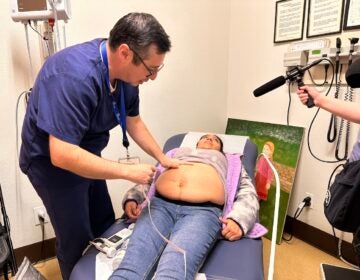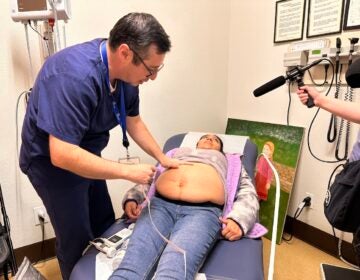Strep throat is making a comeback in Philly after pandemic lows
Strep throat is fairly common among school-aged kids, but cases dropped during the pandemic. Now, infections are soaring.

This handout image provided by the National Institute of Allergy and Infectious Diseases shows an electron microscope image of Group A Streptococcus (orange) during phagocytic interaction with a human neutrophil (blue). The same bacteria that cause simple strep throat sometimes trigger bloodstream or even flesh-eating infections instead, and over the years, dangerous cases have increased. Now researchers have uncovered how some strains of this bug evolved to become more aggressive. (National Institute of Allergy and Infectious Diseases via AP)
Sore throat, painful swallowing, fever, and swollen glands — these are the classic signs of a streptococcal bacterial infection, which before the pandemic, was fairly common.
Cases of strep throat dropped steeply during the height of COVID-19, when physical distancing and masking requirements were in place. But as the pandemic’s hold on the U.S. weakens, strep is the latest disease to make a resurgence in Philadelphia and across the country.
“We’ve been sheltered and then we get re-exposed,” Dr. Ericka Hayes, medical director of infection prevention and control at Children’s Hospital of Philadelphia, said. “It’s kind of similar to what we saw with RSV and influenza with the young kids this fall and winter.”
The Centers for Disease Control and Prevention has been monitoring an uptick in strep throat cases since the fall. The agency warned health providers of an increase in the number of invasive strep infections, which goes beyond the throat and moves into the blood, muscles, and lungs.
Strep spreads through contact with respiratory droplets that contain the bacteria. This can happen from coughing or sneezing, or if someone shares drinking glasses or eating utensils with a person who is sick.
Infections are most common among children 5 to 15 years old, and a typical season for strep throat coincides with the school year.
In Philadelphia, Dr. Dan Taylor, a pediatrician at St. Christopher’s Hospital for Children, said cases have been consistently high this winter and spring.
“Strep is very predictable, typically,” Taylor said. “What we haven’t predicted in 2023 is, at least anecdotally, a doubling of strep infections that we’re seeing here. It’s an everyday occurrence, multiple times a day.”
At the same time, there’s been a nationwide shortage of liquid amoxicillin, the bubble gum pink antibiotic usually prescribed to children for strep throat and other infections.
Taylor said this has been an issue especially for children who have difficulty taking medications as chewables or pills.
“We’ve heard families that actually have called our nurses and said, ‘I’ve gone to three, four pharmacies and they don’t have amoxicillin,’ and we have had to change it to a second-line treatment,” he said.
Second-line treatments include other antibiotics that can be used for strep throat, but Hayes said some of them are stronger and cover a broader range of bacterial infections. While these medications are effective, they’re not typically the first-line treatment for strep.
“We’re killing off more of those good bacteria than we need to, because we’re using a stronger antibiotic than we need to,” Hayes said.
Pediatricians still recommend that people with symptomatic strep infections complete some course of antibiotic treatment. Most people can return to work or school 24 hours after starting medication.
In rarer cases, if strep is left untreated, it can cause complications like kidney inflammation and rheumatic fever, which can affect the heart, joints, brain, and skin.
Hayes said good handwashing and hygiene can go a long way in limiting the risks of infection.
“So, coughing into my elbow, perhaps wearing a mask if I’m having those kinds of symptoms so those droplets are less likely to reach others,” she said.
Strep throat infections typically begin to drop off in May and June, but Taylor said the pandemic has made it more difficult to predict the future of common illnesses like strep, at least in the immediate aftermath of COVID-19.
“I’ve been doing this for 25 years and I used to be confident in answering these kinds of questions,” Taylor said. “I am hopeful that it follows the typical course and starts petering out during the summer, but to be determined.”
WHYY is your source for fact-based, in-depth journalism and information. As a nonprofit organization, we rely on financial support from readers like you. Please give today.







